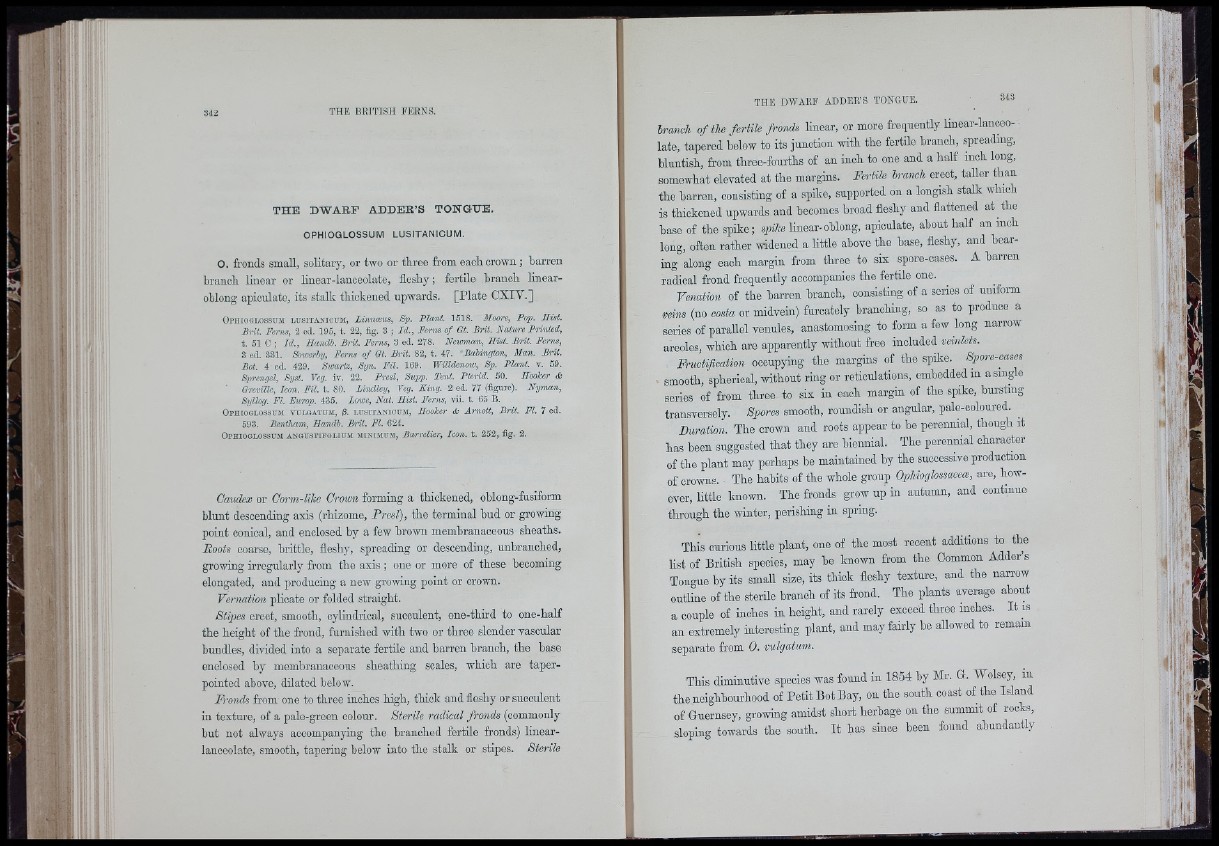
THE DWAEE ADDER’S TONGUE.
OPHIOGLOSSUM LUSITANICUM.
O. fronds small, solitary, or two or three from each crown ; barren
branch Hnear or liuear-lanoeolate, fleshy; fertile branch linear-
oblong apioulate, its staUi tbiokoned upwards. [Plate CXIV.]
O p h io g lo s s um l u s i t a n i c u m , Linncms, Sp. Plant. 1518. Moore, Pop. Hist.
B rit. Ferns, 2 ed. 195, t . 22, fig. 3 ; Id ., Ferns o f Gt. BrU. Nature Printed,
t . 51 C ; Id ., Handb. Brit. Ferns, 3 ed. 278. Newman, Hist. Brit. Ferns,
3 ed. 331. Sowerhy, Ferns o f Gt. Brit. 82, t. 47. Bahington, Man. Brit.
Bot. 4 ed. 429, Swartz, Syn. Fil. 169. Willdenow, Sp. Plant, v. 59.
Sprengel, Syst. Yeg. iv. 22. Presl, Supp. Tent. Pterid. 50. Hooker A
' Greville, Icon. Fil. t . 80. Bindley, Veg. King. 2 ed. 77 (figure). Nyman,
Syllog. Fl. Europ. 435, Lowe, Nat. Hist. Ferns, vii. t. 65 B.
O p h io g lo s s um v u l g a t u m , 0. l u s i t a n i c u m . Hooker A Arnott, Brit. Fl. 7 ed.
693. Bentham, Handb. Brit. Fl. 624.
O p h io g lo s s um a n g u s t i f o l i u m m in im u si, Barrelier, Icon, t , 252, fig. 2,
Caudex or Corm-Uke Croton forming a thickened, ohlong-fusiform
blunt descending axis (rhizome, Presl), the terminal hud or growing
point conical, and enclosed by a few brown membranaceous sheaths.
Boots coarse, brittle, fleshy, spreading or descending, unbranohed,
growing irregularly from the axis ; one or more of these becoming
elongated, and producing a new growing point or crown.
Vernation pHoate or folded straight.
Stipes erect, smooth, cylindrical, succulent, one-third to one-half
the height of the frond, fmmished with two or three slender vascular
bundles, divided into a separate fertile and barren branch, the base
enclosed by membranaceous sheathing scales, which are taper-
pointed above, dilated helow.
Fronds from one to three inches high, thick and fleshy or succulent
in texture, of a pale-green colour. Sterile radical fronds (commonly
but not always accompanying the hranohed fertile fronds) linear-
lanceolate, smooth, tapering helow into the stalk or stipes. Sterile
branch of the fertile fronds linear, or more frequently linear-lanceolate,
tapered helow to its junction with the fertHe branch, spreading,
bluntish, from three-fourths of an inch to one and a half inch long,
somewhat elevated at the margins. Fertile branch erect, taller than
the barren, consisting of a spike, supported on a longish stalk which
is thickened upwards and becomes broad fleshy and flattened at the
base of the spike; spike linear-ohlong, apioulate, about half an inch
long, often rather widened a Httle above the base, fleshy, and hearing
along each margin from three to six spore-oases. A barren
radical frond frequently accompanies the fertile one.
Venation of the barren branch, consisting of a series of uniform
wins (no costa or midvein) furcately hranohing, so as to prod’aoe a
s e r i e s of paraUel venules, anastomosing to form a few long narrow
areoles, which are apparently without free included veinlets.
Fructification oooupyiug the margins of the spike. Spore-cases
smooth, spherical, without ring or retioulations, embedded in a single
series of from three to six in each margin of the spike, bursting
transversely. Spores smooth, roundish or angular, pale-coloured. ^
Buration. The crown aud roots appear to he perennial, though it
has been suggested that they are biennial. The perennial character
of the plant may perhaps he maintained by the successive production
of crowns. - The habits of the whole group Ophioglossaceai, are, however,
little known. The fronds grow up in autumn, and continue
through the winter, perishing in spring.
This curious little plant, one of the most recent additions to the
list of British species, may he known from the Common Adder’s
Toiwue hy its small size, its thick fleshy texture, and the narrow
outHne of the sterile branch of its frond. The plants average about
a couple of inches in height, and rarely exceed three inches. It is
an extremely interesting plant, and may fairly be allowed to remain
separate from 0. vulgatum.
This diminutive species was found in 1854 by Mr. G. Wolsey, in
the neighbourhood of Petit Bot Bay, on the south coast of the Island
of Guernsey, growing amidst short herbage on the summit of rooks,
sloping towards the south. It has since been fonnd abundantly
A :
4 iff;
!i'';
i ’flifei
f